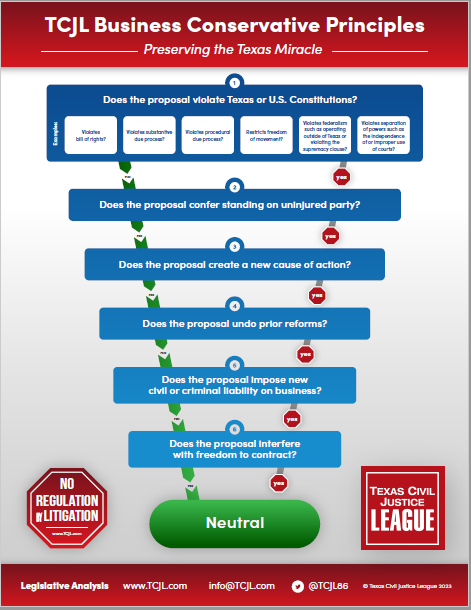
Justice Evan Young
The Texas Supreme Court has issued a writ of mandamus directing a trial court to vacate its order granting a new trial in a personal injury case in which the jury awarded substantial damages to the plaintiff.
In re Rudolph Automotive, LLC d/b/a Rudolph Mazda and Rudolph Chevrolet, LLC (No. 21-0135; delivered June 16, 2023) arose from a serious injury accident that occurred on the premises of an automobile dealership. Plaintiff sued the dealership on behalf of her mother, an employee who was struck in the parking lot by another employee’s truck after they had been drinking beer after a long day of work. The dealership’s sales manager provided the money for the beer. Plaintiff’s mother suffered serious injuries, including a traumatic brain injury that confined her to a nursing home for seven years prior to her death in 2020. Plaintiff brought suit against several defendants, asserting negligence, failure to train, and premises liability. After a three-week trial, the jury returned a verdict awarding more than $4 million, including a little more than $300,000 in non-economic damages. The court discharged the jury without objection by the parties. A few weeks later, however, the dealership filed a motion to disregard the jury’s finding that the dealership was 10% at fault, although the jury twice answered that it was not negligent. Plaintiff likewise filed motions for judgment notwithstanding the verdict and for a new trial, based on a defense expert’s violation of the trial court’s order limiting testimony about plaintiff’s mother’s drinking habits. The trial court granted the plaintiff’s motion for new trial. The El Paso Court of Appeals denied the dealership’s petition for writ of mandamus. The dealership once again sought mandamus in SCOTX.
In an opinion by Justice Young, SCOTX conditionally granted the writ. Justice Young’s analysis commenced with a discussion of In re Columbia Medical Center of Las Colinas, Subsidiary, L.P., 290 S.W.3d 204 (Tex. 2003), the first decision in which SCOTX placed guardrails around a trial court’s unfettered discretion to grant a motion for new trial “in the interest of justice and fairness.” The Columbia court requires trial courts to state specific, “meaningful” reasons for granting a new trial to protect both the constitutional entitlement to a jury trial and to prevent “a constitutionally intolerable substitution of judicial will for that of the jury, which undermines the right to a jury trial.” In subsequent decisions, the Court refined Columbia to require the trial court to link the reasons for ordering a new trial to evidentiary support in the record. Appellate courts reviewing a new trial order “must be able to conduct merits-based review of new trial orders,” Justice Young wrote, quoting In re Toyota Motor Sales, U.S.A., Inc., 407 S.W.3d 746, 758 (Tex. 2013). “If, despite conformity with the procedural requirements of our precedent, a trial court’s articulated reasons are not supported by the underlying record, the new trial order cannot stand.” Id. (emphasis in the original).
Turning to the facts of the case, Justice Young examined each of the trial court’s four stated reasons for ordering a new trial. First, the trial court cited the jury’s apportionment of 10% fault to the dealership despite its non-negligence finding. Here, no party objected to an irreconcilable conflict in the verdict before the jury was discharged, which would have allowed the court to correct the alleged error. Since nobody made a timely objection, nobody could “later invoke the conflict in the jury’s answers to win a new trial on appeal.” In this case, however, the trial court wanted a new trial and exercised its own authority in ordering one. Thus the appellate court must examine whether the trial court committed a legal error in doing so, abusing its discretion in the process. As to this issue, the Court held that the trial court should merely have harmonized the jury verdict by reapportioning the dealership’s 10% to other parties who were found negligent. The appropriate remedy for a party’s disagreement with that approach is appeal, not a new trial.
Second, the trial court took issue with the jury’s failure to award plaintiff damages for past disfigurement or loss of past household services, as well as to award sufficient damages for past and future pain and suffering and physical impairment. (In other words, the trial court didn’t think the jury awarded enough.) Noting that the categories of noneconomic damages overlap and that the jury charge acknowledged that by warning the jury not to award duplicative damages, Justice Young found no explanation in the trial court’s order of how the jury violated its instructions by allocating noneconomic damages the way it did. As to the trial court’s disagreement with the amount of the damages, the Court likewise found nothing in the order to indicate how and why the damages were either too small or the jury could not have awarded them in one category rather than another, overlapping one. Simply put, the order did not take account of the evidence in any meaningful way or show why the jury’s answers were contrary to the “great weight and preponderance” of the evidence.
Third, the trial court’s order alluded to SCOTX’s decision in another case that came down on the same day of the jury verdict, which involved a scope and course of employment issue in the non-subscriber context. Justice Young made quick work of this issue, finding the decision inapposite to the facts of this case and, even if it was, that post-trial proceedings were the appropriate way to deal with any “matter-of-law” issues that the decision raised.
Finally, the Court found that the violation of the trial court order excluding witness testimony regarding plaintiff’s drinking habits was sufficiently cured by the trial court’s emphatic instructions to the jury to ignore the testimony and the jury’s acknowledgement by poll that it would adhere to those instructions. While cases exist in which the harm of improper testimony or argument is incurable (such as a 2008 SCOTX decision in which plaintiff’s counsel compared the defendant nursing home to a Nazi medical experiment program), the “nature, degree, and extent” of the error must be so extreme “that an instruction from the court or retraction of the argument could not remove its effects” (quoting Living Ctrs. of Tex., Inc. v. Penalver, 256 S.W.3d 678, 681 (Tex. 2008)). As Justice Young stated, those extreme errors “strike[] at the heart of the judicial process,” but this one did not. In a long trial with a ton of evidence, a single violation of a motion in limine, immediately countered by a timely objection and vigorous judicial response (which, by the way, demolished the credibility of the defense witness), constituted an appropriate cure. Moreover, we presume that jurors follow the court’s instructions and should not be second-guessed in the absence of an extreme case of incurability.
SCOTX directed the trial court to vacate the order, reconcile the verdict, and conduct whatever post-trial proceedings it normally would. In our view, this is a very instructive opinion that advances the jurisprudence of the state. TCJL took a strong interest in the Columbia case when it was before the Court in 2003, largely because trial courts in certain areas of the state were apt to set aside defense verdicts without any reason for doing so other than that the jury didn’t think a defendant did anything wrong. This decision emphasizes the fundamental rationale for placing some limits on the trial court’s discretion in this area: to protect jury trials and to trust the jury’s judgment when it has applied the evidence to properly submitted questions in accordance with the court’s instructions. We either trust juries or we don’t, no matter which side wins.












